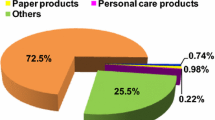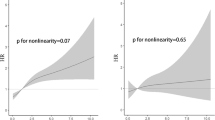Abstract
Trichlorophenols such as 2,4,5-trichlorophenol (2,4,5-TCP) and 2,4,6-trichlorophenol (2,4,6-TCP) are organochlorine compounds to which the general public can be exposed via contaminated food, water, and air. This study assessed exposure to 2,4,5-TCP and 2,4,6-TCP in Koreans age 18–69 years based on the Korean National Human Biomonitoring Survey conducted in 2009. Using data from 1,865 representative Koreans, we found that the geometric mean urinary concentrations of 2,4,5-TCP and 2,4,6-TCP were 83.4 pg/mL [95 % confidence interval (CI) = 78.6–88.6] and 0.39 ng/mL (95 % CI = 0.35–0.42), respectively. The creatinine-adjusted geometric mean 2,4,5-TCP and 2,4,6-TCP levels were 78.8 ng/g creatinine (95 % CI = 73.8–84.1) and 0.36 μg/g creatinine (95 % CI = 0.33–0.40), respectively. Of the Korean adult population, about 67.5 and 87.5 % had respective urine 2,4,5-TCP and 2,4,6-TCP concentrations >0.05 ng/mL (the limit of detection, LOD). Urine 2,4,5-TCP concentrations were significantly associated with age and place of residence, whereas urine 2,4,6-TCP concentrations were higher in rural residents. These findings suggest that most Koreans had detectable levels of 2,4,5-TCP and 2,4,6-TCP in their urine and that the body burden of 2,4,5-TCP and 2,4,6-TCP varied according to demographic and geographic factors.

Similar content being viewed by others
References
ASTDR (1999) Toxicological profile for chlorophenols. Agency for Toxic Substances and Disease Registry, US Department of Health and Human Service
Becker K, Schulz C, Kaus S, Seiwert M, Seifert B (2003) German environmental survey 1998 (GerES III): environmental pollutants in the urine of the German population. Int J Hyg Environ Health 206:15–24
Calafat AM, Ye X, Wong LY, Reidy JA, Needham LL (2008a) Exposure of the U.S. population to bisphenol A and 4-tertiary-octylphenol: 2003–2004. Environ Health Perspect 116:39–44
Calafat AM, Ye X, Wong LY, Reidy JA, Needham LL (2008b) Urinary concentrations of triclosan in the U.S. population: 2003–2004. Environ Health Perspect 116:303–307
CDC (2009) Fourth national report on human exposure to environmental chemicals, Centers for Disease Control and Prevention. Atlanta, USA
Cole SR, Chu H, Nie L, Schisterman EF (2009) Estimating the odds ratio when exposure has a limit of detection. Int J Epidemiol 38:1674–1680
Draper WM (2001) Biological monitoring: exquisite research probes, risk assessment, and routine exposure measurement. Anal Chem 73:2745–2760
Hays SM, Aylward LL (2012) Interpreting human biomonitoring data in a public health risk context using biomonitoring equivalents. Int J Hyg Environ Health 215:145–148
He Y, Miao M, Herrinton LJ, Wu C, Yuan W, Zhou Z, Li DK (2009) Bisphenol A levels in blood and urine in a Chinese population and the personal factors affecting the levels. Environ Res 109:629–633
Hill RH Jr, Head SL, Baker S, Gregg M, Shealy DB, Bailey SL, Williams CC, Sampson EJ, Needham LL (1995) Pesticide residues in urine of adults living in the United States: reference range concentrations. Environ Res 71:99–108
Huff J (2012) Long-term toxicology and carcinogenicity of 2,4,6-trichlorophenol. Chemosphere 89:521–525
IARC (1999) IARC Monographs. International Agency for Research on Cancer, Lyon, France
Kauppinen T, Kogevinas M, Johnson E et al (1993) Chemical exposure in manufacture of phenoxy herbicides and chlorophenols and in spraying of phenoxy herbicides. Am J Ind Med 23:903–920
Kim K, Park H, Yang W, Lee JH (2011) Urinary concentrations of bisphenol A and triclosan and associations with demographic factors in the Korean population. Environ Res 111:1280–1285
Mari M, Nadal M, Schuhmacher M, Domingo JL (2013) Body burden monitoring of dioxins and other organic substances in workers at a hazardous waste incinerator. Int J Hyg Environ Health. doi:10.1016/j.ijheh.2013.01.003
National Toxicology Program (2011) 2,4,6-Trichlorophenol. Rep Carcinog 12:424–426
Nichkova M, Marco MP (2006) Biomonitoring human exposure to organohalogenated substances by measuring urinary chlorophenols using a high-throughput screening (HTS) immunochemical method. Environ Sci Technol 40:2469–2477
Rawlings NC, Cook SJ, Waldbillig D (1998) Effects of the pesticides carbofuran, chlorpyrifos, dimethoate, lindane, triallate, trifluralin, 2,4-D, and pentachlorophenol on the metabolic endocrine and reproductive endocrine system in ewes. J Toxicol Environ Health A 54:21–36
Schmid K, Lederer P, Göen T, Schaller KH, Strebl H, Weber A, Angerer J, Lehnert G (1997) Internal exposure to hazardous substances of persons from various continents: investigations on exposure to different organochlorine compounds. Int Arch Occup Environ Health 69:399–406
Trasande L, Attina TM, Sathyanarayana S, Spanier AJ, Blustein J (2013) Race/ethnicity-specific associations of urinary phthalates with childhood body mass in a nationally representative sample. Environ Health Perspect 121:501–506
Vandenberg LN, Chahoud I, Heindel JJ, Padmanabhan V, Paumgartten FJ, Schoenfelder G (2010) Urinary, circulating, and tissue biomonitoring studies indicate widespread exposure to bisphenol A. Environ Health Perspect 118:1055–1070
Ward MH, Colt JS, Metayer C, Gunier RB, Lubin J, Crouse V, Nishioka MG, Reynolds P, Buffler PA (2009) Residential exposure to polychlorinated biphenyls and organochlorine pesticides and risk of childhood leukemia. Environ Health Perspect 117:1007–1013
World Health Organization (2000) The Asian-Pacific perspective: redefining obesity and its treatment, Manila, Philippines
Xu X, Nembhard WN, Kan H, Kearney G, Zhang ZJ, Talbott EO (2011) Urinary trichlorophenol levels and increased risk of attention deficit hyperactivity disorder among US school-aged children. Occup Environ Med 68:557–561
Acknowledgments
This research was supported by the Settlement Research Grant of Keimyung University in 2012.
Conflict of interest
The authors declare that they have no competing financial interests.
Author information
Authors and Affiliations
Corresponding author
Additional information
Responsible editor: Hongwen Sun
Rights and permissions
About this article
Cite this article
Kim, K., Park, H. & Lee, J.H. Urinary concentrations of trichlorophenols in the Korean adult population: results of the National Human Biomonitoring Survey 2009. Environ Sci Pollut Res 21, 2479–2485 (2014). https://doi.org/10.1007/s11356-013-2180-1
Received:
Accepted:
Published:
Issue Date:
DOI: https://doi.org/10.1007/s11356-013-2180-1




